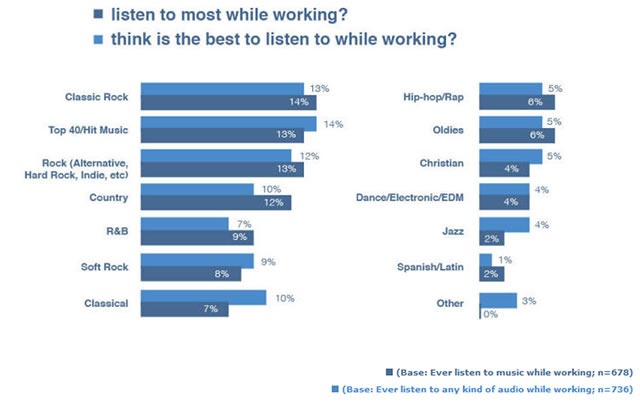Edison Research president, Larry Rosin, has been an avid reader and a contributor to our blog. As Larry explains in today’s guest post, his ’97 landmark at-work study had a profound influence on our company and our clients His new study is must-reading for everyone in radio. He’ll be presenting it at The Radio Show today. – FJ
 In 1997, I was invited to be on the NAB Radio Show’s agenda committee. I went to the first meeting in Washington DC and said: “The NAB should be doing original research – the show should be a place where new findings are presented and discussed.” They asked for a sample topic and I said: “There are a million hypotheses about at-work radio listening that I would love to test.”
In 1997, I was invited to be on the NAB Radio Show’s agenda committee. I went to the first meeting in Washington DC and said: “The NAB should be doing original research – the show should be a place where new findings are presented and discussed.” They asked for a sample topic and I said: “There are a million hypotheses about at-work radio listening that I would love to test.”
They said, in a fashion I would learn is typical, “Great idea! Find someone to fund that research!”
So I turned to Arbitron and to their endless credit they paid for a large in-depth study of at-work radio listening that truly popped the bubble on at-work listening. To wit:
- Associating “at-work” listening with “mid-day” listening as defined by the Arbitron diary, was entirely wrong (and yet this misapprehension continues to this day among many).
- Referring to “at-work” listening as “in-office” listening, as it was by so many back then, is wildly incomplete.
- Most importantly – until that time the working theory was that at-work radio listening is only for women. That study showed that men were as likely as women to listen to the radio at work, and since they are a bit more likely to work – there is more male at-work listening than female listening.
A certain consultant really picked up on this last point – and made tremendous hay for his clients as a result: naturally I’m talking about the author of this blog Fred Jacobs.
Fred pivoted his Classic Rock (and other rock station) clients to take a clear and focused strategy on at-work listening. Many of his stations instituted the “Workforce” promotion – almost always yielding significant returns.
Well – in one of those cycles of history – I was asked by the NAB to do an update of that study 16 years later. (And yes, I was asked to find a way to fund it – we found a great sponsor this time in Radionomy – a new company in the streaming services space that readers should check out). I will be unveiling the results of this latest inquiry today at the now-named “Radio Show” in Orlando.
Check out Radionomy’s infographic for the study’s findings (you can download a PDF of the results here)
What the study shows is an at-work environment that has been utterly transformed over the last 16 years by the Internet – and yet – the need for radio stations to focus on this listening location no less important. And as was the case then – the kinds of stations that Fred’s company provides programming services for – stations that largely target men and stations playing rock music – will want to use this study once again to refocus their energies on at-work.
Think about your workplace in 1997. At the time at my small business – our (then) ten employees shared a single dial-up connection to the Internet (through AOL). When someone needed to get an email or send a file – they yelled through the office for whoever was on to get off. Now of course Edison’s (now 30) employees access the Internet non-stop from the moment they arrive to the time they leave. I don’t doubt something parallel has happened in whatever workplace you inhabit. And of course this single change in the way so many people work has changed media usage at work. In our 1997 study we didn’t even ask about listening to online radio/audio while at work.
 For Classic Rockers – the song remains largely the same. Classic Rock fans who work, our study shows, are more likely to listen to some kind of audio at work. Intriguingly – they are significantly more likely to listen to AM/FM radio in the traditional way, and yet they are no less likely to listen to online options (including the stream of their same Classic Rock station). Classic Rockers just love their radio and their radio stations.
For Classic Rockers – the song remains largely the same. Classic Rock fans who work, our study shows, are more likely to listen to some kind of audio at work. Intriguingly – they are significantly more likely to listen to AM/FM radio in the traditional way, and yet they are no less likely to listen to online options (including the stream of their same Classic Rock station). Classic Rockers just love their radio and their radio stations.
But all is not well. The at-work environment – one where many listeners want a lot of music quantity with minimal interruptions – is now being attacked by online options with lower spot loads. I hope one of the main points of discussion to emerge from my talk is an assessment of realistic commercial loads in our newly competitive environment.
With the advent of PPM, we no longer have a clear look at listening trends at this location in metered markets or nationally. So I hope this study will fill some of that gap – and alongside the crucial work Fred is doing to keep our eyes on the in-car prize, let’s start a serious discussion of how radio stays relevant in that second key location – at-work. My overwhelming sense is that radio stations today don’t talk about at-work the way they used to – it’s probably time to start again.
- Media And Technology In 2025: Believe It Or Not! - April 18, 2025
- In Radio, You Just Never Know - April 17, 2025
- The Secret To Making A Great Podcast (And Great Radio) - April 16, 2025




Leave a Reply